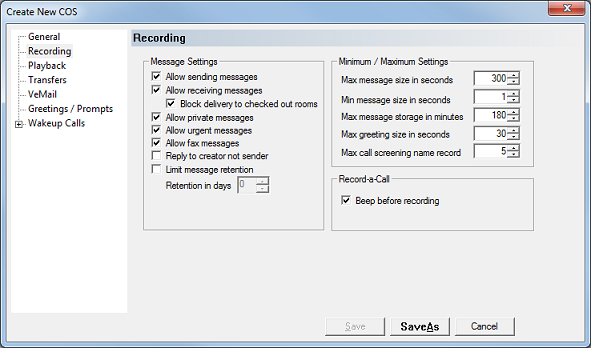|
The Recording tab contains settings for controlling the recording capabilities of the mailbox, including both the sending and the receiving of messages.
There are three broad categories of settings, as shown in the figure below: Message Settings, Minimum/Maximum Settings, and General Settings.

Message Settings
This section contains settings that control what kind of messages, if any, can be sent and/or received, as well as how long messages may be retained before being automatically purged.
Setting
|
Description
|
Allow sending messages
|
Allow the subscriber to send messages directly from the subscriber menu
|
Allow receiving messages
|
Allow the mailbox to receive messages.
If disabled, the mailbox will take the No Input (NI) action in the SDA after playing the greeting and waiting for the DTMF timeout; it will not record a message.
|
Allow private messages
|
Allow the subscriber to send messages marked as private.
Private messages cannot be forwarded to anyone else. This includes VeMail messages.
|
Allow urgent messages
|
Allow the subscriber to send messages marked as urgent.
Urgent messages play before any other new messages, are identified as urgent when played to the recipient, and can trigger notification events tied specifically to the reception of urgent messages.
|
Allow fax messages
|
Allow the mailbox to receive fax messages, if fax is installed and configured.
|
Reply to creator not sender
|
This setting is primarily for messages received from a distribution or group list.
If checked, the reply message will be sent to the subscriber who recorded the message.
If unchecked, the reply message will be sent to the distribution or group mailbox that sent the message (and will, therefore, be sent to all members of that mailbox's distribution or group list).
If the original creator is not a mailbox (such as an outside caller) or the mailbox is not allowed to receive messages, then the reply will be sent to the distribution or group mailbox that sent the message, regardless of this setting.
|
Limit message retention
|
Allow the system to auto-delete messages after a specified number of days.
If disabled, messages will never expire and will never be deleted unless the subscriber deletes them manually. (In the case of guest mailboxes, messages are archived on checkout, and eventually deleted, even if this option is disabled.)
When the system does auto-delete a message, it is moved to the deleted messages queue, where it will remain until the final deletion process clears it out, typically 24 hours later. During that time, you can retrieve the message using the undelete option in the subscriber menu.
The valid range is from 1 to 1825 days (approximately 5 years).
All message queues are affected by this setting.
|
Retention in days
|
The number of days to keep messages before purging them automatically.
Only valid if Limit message retention is enabled.
|
Minimum/Maximum Settings
This section contains settings that control the minimum and maximum sizes for various recordings as well as the total amount of message storage space allowed for each mailbox.
Setting
|
Description
|
Max message size in seconds
|
Maximum length for any one message, in seconds.
The valid range is from 1 to 999 seconds.
|
Min message size in seconds
|
Minimum length for any one message, in seconds.
The valid range is from 0 to 9 seconds.
|
Max message storage in minutes
|
Total amount of time allowed for all stored messages in all queues, in minutes.
The valid range is from 1 to 999 minutes.
|
Max greeting size in seconds
|
Maximum length for any greeting, in seconds.
The valid range is from 1 to 999 seconds.
|
Max call screening name record
|
Maximum length of time to record a name for call screening, in seconds.
The valid range is from 1 to 30 seconds.
Not relevant for SIP systems, which do not support call screening.
|
Record-a-Call Settings
This section contains settings that control the record-a-call (or immediate record) feature. There is just one setting:
Setting
|
Description
|
Beep before recording
|
If enabled, a beep is played before the recording starts, even though neither the greeting nor any prompts are played.
If disabled, the recording begins immediately and silently.
|
|





